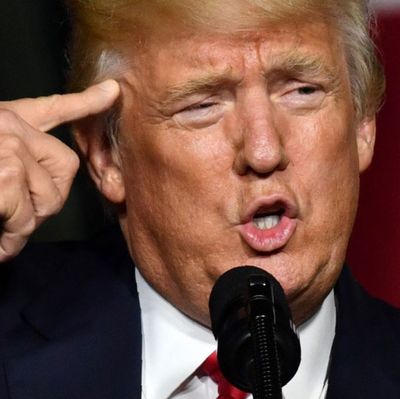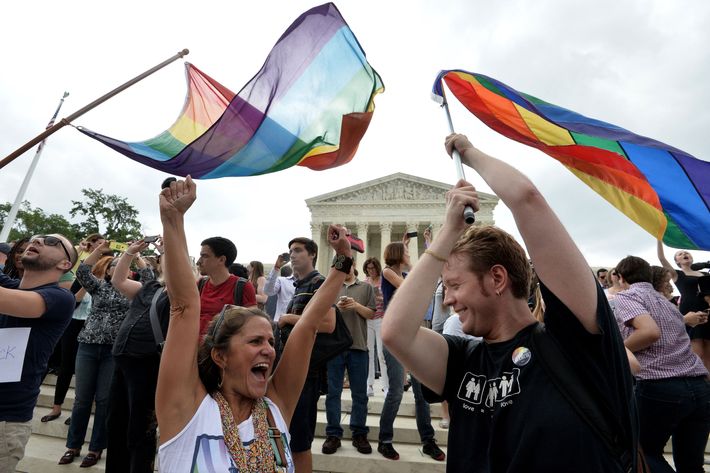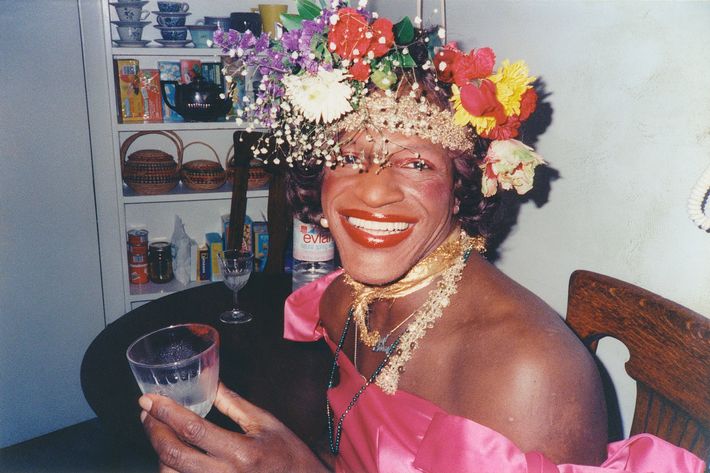
I was mulling, as one does, over this presidency, and something crystallized in my head that I had not quite grasped before. Its policies are best described as simply perverse. The new Senate health-care bill is just the latest shining example. As Peter Suderman explains, it certainly isn’t based on any serious conservative ideas about reforming health care; it has no vision of how it wants health care to be organized; the loss of health care for the working poor will be most intense in Republican districts; and, just as important, a huge amount of it is simply kicked into the future — and could easily be forestalled or nullified by future Congresses and presidents. For good measure, by ending many of the taxes in the bill that make it work, and by removing the individual mandate, it risks sending the insurance markets into a deeper crisis.
So what on earth is the point? For Trump, it seems to me, the whole point is to have a “win.” He doesn’t give a shit about what the bill actually contains. He’ll just lie about it afterward and assume his cult followers will believe him. For Ryan, it’s just a way to make a future tax cut for the superrich more budget-friendly, while pushing the political costs of shredding Medicaid onto some future sucker.
And then you think about those tax cuts Ryan wants so badly. We are told that these cuts will spark so much growth they will pay for themselves — and more. And yet if there is one thing we really do know by now, it is that this strategy has spectacularly failed and failed again to work. Reagan’s tax cuts left the U.S. with an unprecedented peacetime deficit; George W. Bush inherited a small surplus and, after his tax cuts didn’t spur higher growth, handed Obama a Treasury close to bankrupt. In Kansas, the exact same strategy has incurred so much debt that a supermajority of the legislature, led by Republicans, have junked it. To pursue it a third time on a national scale is the definition of madness.
We are also living in an era of extreme inequality. Any responsible politician would be trying to find a way to ameliorate this, if for no other reason than it is deeply dangerous for the stability of our society and the health of our democracy. And yet the policy of the Republicans is to further increase such inequality to levels beyond even the robber-baron era. Again, the only word for this is … perverse.
Ditto, for that matter, the idea that coal is the future of energy, and that climate change is a hoax. There was absolutely no point in withdrawing from the nonbinding Paris Accord — which is why Trump is now lying by claiming, as he did last Wednesday night, that it was binding. It was an utterly pointless way to isolate the U.S. from the rest of the world, and cede leadership to China. There was really no point at all in trashing the modest opening to Cuba under Obama, poisoning relations, and then just fiddling with the details.
Elsewhere in foreign policy, we have just begun a deepening of the war in Afghanistan, the longest in American history, with no strategy in place. We’ve also junked the very careful limits that Obama put on the war against ISIS, leading to increasingly dangerous conflict with the Russians. And we now have a broader Middle East policy that has needlessly junked the core gain of the Obama years. The opening to Iran gave the U.S. far more leverage in the region, balancing out our previous Sunni commitments with a Shiite counterweight. Now Trump has fully committed the United States to one side of an intra-Muslim divide, while trashing Qatar, which houses the most important military base in the entire region. Again: perverse.
And what on earth was the purpose of equivocating about the critical commitment to Article 5 of the NATO Treaty, undermining the core underpinning of the Atlantic alliance — and then affirming it anyway? We haven’t even gotten commitments to more defense spending from the Europeans, apart from what Obama had managed to get them to agree to already. But what we have achieved is an unprecedented rupture in relations with most of the key European allies.
It is also, frankly, perverse to ignore Russia’s blatant attempt to disrupt our elections and to keep reaching out to Putin — when the Congress will rightly deepen sanctions anyway, and Putin will pursue his own ambitions regardless. None of this is coherent strategy, and almost all of it counterproductive.
The only theme I can infer is this: Whatever Obama did, Trump will try to undo. The perversity is the flip side of spite.
Nathaniel Frank’s new book on the long fight for marriage equality, Awakening: How Gays And Lesbians Brought Marriage Equality to America, has one thing going for it: It’s a professional work of history. The only book on the movement we have so far wasn’t. Jo Becker’s hagiography of Chad Griffin, Forcing the Spring — my review is here — was an outright attack on everyone who had worked for the cause decades before Griffin tried to pass himself off as the gay Rosa Parks (yes, the book actually called him that). Awakening is therefore by default the best account we have, but it’s also a truly impressive, nuanced, fair account in its own right. It’s astonishing to me that the New York Times and the Washington Post have yet to review it. It relays the lung-filling highs and stomach-churning lows of the long trek toward gay dignity. Better still, it brings into focus the small band of disparate individuals who somehow brought what was unimaginable into reality. Many people think marriage was won overnight. This book proves it wasn’t.
But its chief merit is that it explains for straight people and the younger gay and lesbian generations just how deeply divisive this issue was in the gay world for so long … all the way back to the 1950s, when the story really starts. The core gay divide in the gay world has always been between those who wanted equality and dignity in mainstream society and those who wanted to revolutionize and subvert the mainstream itself. Civil marriage was an issue where this divide was perhaps deepest. You can go back to the old gay magazine, One, published by the Mattachine Society, and see exactly the arguments that erupted later. In 1953, Frank notes, it ran an essay called “Homosexual Marriage?” The question mark was more like a gasp. In a screed against the normalization of gays, it worried that “equal rights means equal responsibilities. Equal freedoms means equal limitations.” A decade later, in 1963, a counterpoint appeared: “Let’s Push Homophile Marriage.” The term homophile itself was an attempt to redefine gay men as more than just sexual. The argument: “It seems to me that when society finally accepts homophiles as a valid minority with minority rights, it is going first of all to accept married homophiles. We are, after all, closest to their ideals.” In some ways, the gay-rights movement has spent the last few decades having that same fight over and over again.

But it is, of course, more complicated and interesting than that. Marriage equality was both subversive and integrationist. It subverted nascent gay culture and traditional heterosexual assumptions. And yet it was also a uniquely powerful symbol of integration, equality, and a common humanity. It was based on a submerged reality, which was that many gay men and especially lesbians had always been in committed relationships — and that that experience was a vital bridge with heterosexuals, who usually comprised the rest of our families. The proof of that is in the number of gays and lesbians now in civil marriages: around a million.
Nonetheless, for the longest time, the fight for marriage had almost no constituency in the post-1969 gay world — too conservative for some, way too utopian for others — and was kept aloft by a tiny group of activists, lawyers, and writers, who never gave up, despite setbacks at almost every turn. The biggest gay-rights group, the Human Rights Campaign, for example, remained hostile to pushing for marriage all the way through to the mid-aughts. The central figure from the get-go, Evan Wolfson, had to fight the rest of the movement continuously to keep the dream alive. It’s easy, in the wake of victory, to forget that story — but Frank covers its nuances better than anything else I’ve read. And he gives everyone their due. Toward the end of the book, he focuses a little too much on the litigation and not enough on the culture, but this is a small flaw in an otherwise indispensable account.
What resolved the gay divide, in the end, was the religious right. When George W. Bush endorsed the Federal Marriage Amendment in 2004, as Frank explains, almost everyone in the gay movement realized that something fundamental to our human dignity and civil rights was at stake. Old ideological divisions briefly evaporated in the heat of the struggle, and the fast-rising support for the idea among gays and lesbians themselves turned into a grassroots revolution. The long game eventually, cumulatively brought the breakthrough. What began as as light covering of snow, easily brushed away, became, snowflake by snowflake, a drift, which eventually precipitated an avalanche. We live in the wake of it.
The other day, I managed to see the new documentary by David France, The Death and Life of Marsha P. Johnson, at the Provincetown Film Festival. It shines a piercing light on another cleavage in the gay world. And that’s the long tension between gays and lesbians and transgender people. There’s an astonishing clip in the movie of a gay-rights rally for New York Pride in 1973, when a transgender instigator of Stonewall, Sylvia Rivera, forced herself onstage and grabbed the microphone. And as she began her impromptu speech, you can see and hear the crowd booing, shouting, and heckling at the interloper. It’s a riveting and horrifying moment. For all the high-flown talk about the “LGBT community,” the truth is, these three groups have often had little in common — apart from marginalization. Many gay men have sadly long been uncomfortable around transgender people; and many lesbians have bristled at times at the notion that transgender women are truly the same as women who have been physiologically such from birth.
And then there was Marsha P. Johnson, an icon of Stonewall and the lost gay world of the West Village in the 1980s and early 1990s. I actually don’t know quite how to identify her. She dressed as a woman but also as a man. Her family refer to her in the film interchangeably as “he” and “she.” She floated through all these divisions and seemed to belong in every camp. Was she a drag queen? Or transgender? Or a cross-dresser? In the end, I think, her charisma transcended all these identities. She was an individual, and in some ways, a saint. Gentle, African-American, always beaming, bringing outcasts into her home, shimmering through Pride like a vision of divine love, she seemed to have no enemies in an often contentious community. And she died like a martyr, her body suddenly washing up at the Christopher Street piers in 1992, quickly designated a suicide, with only the most cursory of investigations.

No one who knew her believed she killed herself. And the movie tries, all these years later, to solve the mystery of her death. Sadly, it doesn’t quite deliver the payoff you want, but you learn so much along the way it doesn’t really matter. As an evocation of a different era, the movie is quite wonderful. I have just two quibbles. There’s an implication that the Stonewall riots were instigated by trans people of color, who were then erased by the white cis middle class. This is far too pat. It’s critical that the key trans figures at Stonewall be recognized. Ditto gay men of color. Putting them front and center on that fateful night is vital for the historical record, and I’m glad this movie exists for that reason alone. But you only have to look at the actual photographs of the riots to see masses of young gay white men as well, lining up on the streets, jumping into the melee. And in some ways, it was the rebellion of those with much more to lose that marked a shift in consciousness.
There’s also a statement in the movie that there was no gay-rights movement before Stonewall. This is just untrue, and it erases the legacy of the early gay rights pioneers in the 1950s, like Frank Kameny, Barbara Gittings, and Harry Hay, who founded the movement in the terrifying era of the lavender scare. People who risked their lives and careers marching in front of the White House in the 1950s, who started the Mattachine Society and the Daughters of Bilitis, who laid the foundations for marriage equality, gays in the military, nondiscrimination in employment, and coined the term “Gay is Good,” deserve not to be forgotten. This movie wipes them from history.
But there I go again, I suppose. It wouldn’t be a gay movie without an internal gay controversy. And the internecine fights will never fully end because the accident of homosexual orientation — more than any other —knows no single demographic, or gender, or race, or class. To form a coherent movement out of that massive, random diversity was never going to be easy. Pride Marches this year have been disrupted and halted by groups connected with Black Lives Matter who oppose the mainstream corporate support and openly gay police organizations that so many of us regard as huge achievements of integration, rather than blights. But purist factions have always tried to impose a singular vision on a very non-singular group of people. It has always been that way, from the very beginning. Love breaks through every human identity, and so must a movement rooted in the search for love. And of that divisiveness and contentiousness, spats and feuds, marches and countermarches, and rare, fleeting moments of unity, I am, in some, yes, perverse way, proud.
See you next Friday.





























